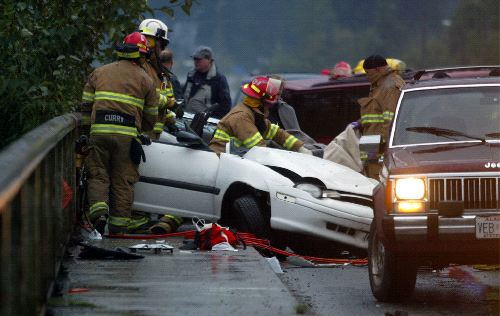Michael Fumento
Factual · Powerful · Original · Iconoclastic
Drivers—Not Cars—Are The Greater Danger
April 03, 2010 · Michael Fumento · Independent Journalism Project · Toyota AccelerationIt’s like worrying about a pesky mosquito while surrounded by hungry man-eating lions. The media have gone wild over two accidents and five deaths the government has attributed to

With rare exceptions, cars don’t kill people. People kill people.
Even bonafide defects rarely "cause" accidents. "Whether it’s a defect or a child darting into the road, most crashes occur because drivers don’t leave an adequate safety margin," says Leonard Evans, author of the book Traffic Safety. In one of those two Toyota accidents, the driver went 20 miles without putting the car into neutral, pushing the ignition button or glancing down to see there was a mat wedged under his accelerator and yanking it back. He ultimately slammed into another vehicle, incinerating its occupant.
Evans bemoans what he calls "the lethal American obsession with technical flaws." Indeed, a 1985 Federal Highway Administration study found only 2% of accidents were entirely related to the vehicle factors, while 12% could at least partly be blamed on the vehicle. Meanwhile 57% were due solely to driver error, and 93% involved driver error. Since then, dozens of new safety improvements have been added to vehicles.
Because of these new features, along with roadway improvements and increased seatbelt usage, American auto fatalities have steadily declined since the 1960s. But the rate has been agonizingly slow compared to that of other industrialized nations. Thus in 1970 the U.S. had the lowest fatality rate per distance driven, but by 2008 it was 12th and it’s sinking still.
While in comparable countries vehicle deaths have fallen almost 60% since 1979, the U.S. decline has been less than half theirs. (See chart.) Had it been the same, 21,000 fewer Americans would have suffered violent deaths last year.
| col 1 | col 2 | col 3 | col 4 |
|---|---|---|---|
| Country | 1979 Vehicle Fatalities | 2008 Vehicle Fatalities | Percent Decline |
United States
| 51,093
| 37,261
| 27.1
United Kingdom
| 6,532
| 3,707
| 58.4
Canada
| 5,863
| 2,371
| 59.6
Australia
| 3,508
| 1,466
| 58.2
Sources: International Traffic Safety Data & Analyses Group, IRTAD Road Safety 2009; Leonard Evans, Traffic Safety, 2004
And here’s the truly horrifying realization. America’s slow-motion progress since 1979 has cost over 300,000 lives—more than 55 times the number of Americans who have died in both Iraq and Afghanistan.
There can and will be more vehicle safety improvements. But we must concentrate on the greatest cause of accidents, not the least. We must focus on the drivers, not the cars. Yet aside from the Mothers Against Drunk Driving campaigns, Americans are loathe to address the real problem of highway carnage.
"There’s strong resistance to tough enforcement of traffic safety laws," says Russ Rader of the Insurance Institute for Highway Safety. He says it’s related to Americans’ attitudes in driver surveys, which repeatedly show about 90% of Americans rank themselves as above-average drivers—and that’s not just in Lake Woebegone. "Traffic offenders never believe they’re the problem," says Rader. "’It’s all those other idiots. So why I should I be forced to obey traffic laws that inconvenience me?’"
The problem may be getting worse. According to a new Washington Post poll, "Fully 80% of area adults often see distracted driving, with reports of such behavior surging in the past five years." More than two-thirds said they often witness overly aggressive driving. Yet only one in eight considered his driving too aggressive. And while almost everyone polled said sending or reading texts or e-mails while driving should be illegal, nearly a fourth of respondents said they do so.

He’s unsafe at any speed.
Yet all we ever consider is more vehicle safety improvements. So in response to the Toyota flap, the Obama administration is considering making mandatory the installation of break override systems—software that cuts the throttle when the brake is applied.
Despite all the focus on Toyota, it’s
Unfortunately, all the incentives are to keep blaming carmakers. That’s whether you’re Ralph Nader, the secretary of transportation, a congressman, an organization like the Center for Auto Safety (note: not "Driving Safety"), a trial lawyer or a reporter who always shoots for the sensational.
Various groups like Rader’s, AAA and the American Safety Council do talk about driver error, but until there’s an equivalent of an activist group like MADD for drivers generally, nothing will get done. It’s human nature to be terrified of new and allegedly mysterious risks, even as we’ve made peace with the old ones. But with corpses piling up at 100 a day, this peace treaty must end.
